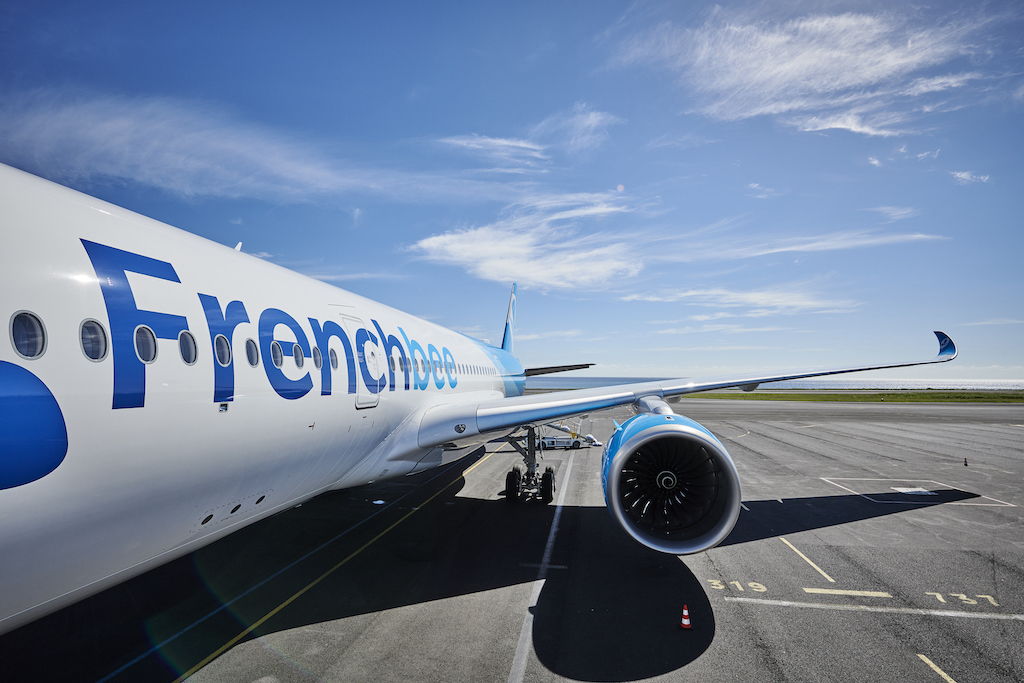French Bee to Resume San Francisco Flights, Increase Newark Frequencies

Photo Credit: Leisure carrier French Bee will resume the Paris-San Francisco-Tahiti flights suspended by the pandemic. French Bee
When French Bee launched its Paris Orly-Newark flights in July, the Delta variant had yet to wreak its havoc on the U.S. Now, several months later, the leisure carrier is confident in the recovery enough to increase frequencies on the route and to resume its Paris-San Francisco-Tahiti flights, which had shifted its technical stop to Vancouver after the U.S. barred entry to most Europeans last year.
The San Francisco flights will restart in November, and the Newark flights, now three times per week, will go up to four weekly flights in December. This could flex upward if demand warrants, President Marc Rochet said.
The carrier expects demand to come roaring back when the U.S. reopens to Europeans in November, but its optimism is tempered by a measure of caution. The Biden administration announced its plans to lift most restrictions for vaccinated travelers but has yet to specify a date, other than the month of November. Most of the carrier's sales originate in France or elsewhere in Europe, but French Bee has yet to see the same kind of surge in bookings that Virgin Atlantic and other carriers have reported. Rochet attributes this relative hesitance to the lack of details from the Biden administration on its plans. "There is a lot of clarity that is missing," Rochet told Airline Weekly. "We will have a real peak when the clarity is there."
But when that clarity arrives, Rochet said the demand will be "huge." Demand first will come from visiting friends and relatives (VFR) traffic, followed by leisure travelers and students returning to universities abroad. "Business travel will be very low," he said. "Our model based on economy [class] and premium economy will be strong."
Since it launched the Newark flight, French Bee's bookings mainly have come from VFR, inbound from the U.S. Traffic has mainly been one way, thanks to the travel restrictions. Since the bulk of French Bee's demand has come from inbound VFR traffic, the carrier says most itineraries don't end in Paris but continue on to destinations around the country. From the July 14 launch to September 28, French Bee carried about 20,000 passengers on the Newark-Paris route.
Inbound tourism demand is an area of potential growth for the carrier. Although it is well known in France, its brand recognition among U.S. travelers is low, Rochet said. "To be clear, we didn't break even, and we didn't make money," he said. "Still, we are a bit satisfied with the result."
The carrier has had time to build market share now that its much larger competitors — the U.S. network carriers, IAG, and Air France-KLM — have stepped back from their transatlantic dominance. Air France-KLM alone had 64 daily flights to the U.S. before the pandemic, Group CEO Ben Smith said at the Skift Global Forum in September.
"We recognize that Air France is a very strong competitor," Rochet said. "My feeling is that they will not come back as they were in 2019 for a very long time." Air France's fleet of widebodies equipped with large premium cabins will be a liability for the carrier when business travel — now widely thought to recover only by 2024 — remains depressed. "It will be very costly for [Air France] to fly to the U.S. and not have that business-class revenue," Rochet added. "Our product is better suited to the market and also is cheaper to operate, so we are very optimistic."
New entrants in the low-cost longhaul market, like Iceland's Fly Play and Norway's Norse Atlantic, also do not trouble Rochet, because their focus is on Northern Europe and not on France. And even if they do offer connections or direct flights to France, Rochet is not worried. "We of course do not think we will have the whole market to ourselves," he said. "It would be totally stupid and arrogant to think so."
When the Newark flight launched, Rochet said the first few flights were almost entirely cargo. Freight remains an important revenue stream for the carrier, but it suffers from a lack of brand recognition among U.S. freight forwarders and shippers. Most of the carrier's cargo on the Newark flights originates in France.
French Bee's Airbus A350s can carry up to 16 metric tons of cargo, but the carrier has been averaging about 12 metric tons on the Newark flights. Part of this is the changing nature of air freight, fueled by e-commerce, Rochet said: Package freight is light but it occupies a lot of space for its weight.
The carrier's fleet plans have changed slightly since the summer. Now, it expects to take delivery of its fifth A350 in December, instead of October. Its sixth A350 will arrive in June 2022. One benefit of the pandemic is that there are a lot of "cheap airplanes on the market, even A350s," he said. "So we know we can get more if needed, but we are cautious people."
